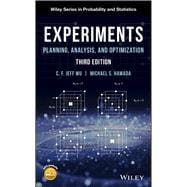Praise for the First Edition:
"If you ... want an up-to-date, definitive reference written by authors who have contributed much to this field, then this book is an essential addition to your library."
—Journal of the American Statistical Association
A COMPREHENSIVE REVIEW OF MODERN EXPERIMENTAL DESIGN
Experiments: Planning, Analysis, and Optimization, Third Edition provides a complete discussion of modern experimental design for product and process improvement—the design and analysis of experiments and their applications for system optimization, robustness, and treatment comparison. While maintaining the same easy-to-follow style as the previous editions, this book continues to present an integrated system of experimental design and analysis that can be applied across various fields of research including engineering, medicine, and the physical sciences. New chapters provide modern updates on practical optimal design and computer experiments, an explanation of computer simulations as an alternative to physical experiments. Each chapter begins with a real-world example of an experiment followed by the methods required to design that type of experiment. The chapters conclude with an application of the methods to the experiment, bridging the gap between theory and practice.
The authors modernize accepted methodologies while refining many cutting-edge topics including robust parameter design, analysis of non-normal data, analysis of experiments with complex aliasing, multilevel designs, minimum aberration designs, and orthogonal arrays.
The third edition includes:
- Information on the design and analysis of computer experiments
- A discussion of practical optimal design of experiments
- An introduction to conditional main effect (CME) analysis and definitive screening designs (DSDs)
- New exercise problems
This book includes valuable exercises and problems, allowing the reader to gauge their progress and retention of the book's subject matter as they complete each chapter.
Drawing on examples from their combined years of working with industrial clients, the authors present many cutting-edge topics in a single, easily accessible source. Extensive case studies, including goals, data, and experimental designs, are also included, and the book's data sets can be found on a related FTP site, along with additional supplemental material. Chapter summaries provide a succinct outline of discussed methods, and extensive appendices direct readers to resources for further study.
Experiments: Planning, Analysis, and Optimization, Third Edition is an excellent book for design of experiments courses at the upper-undergraduate and graduate levels. It is also a valuable resource for practicing engineers and statisticians.









